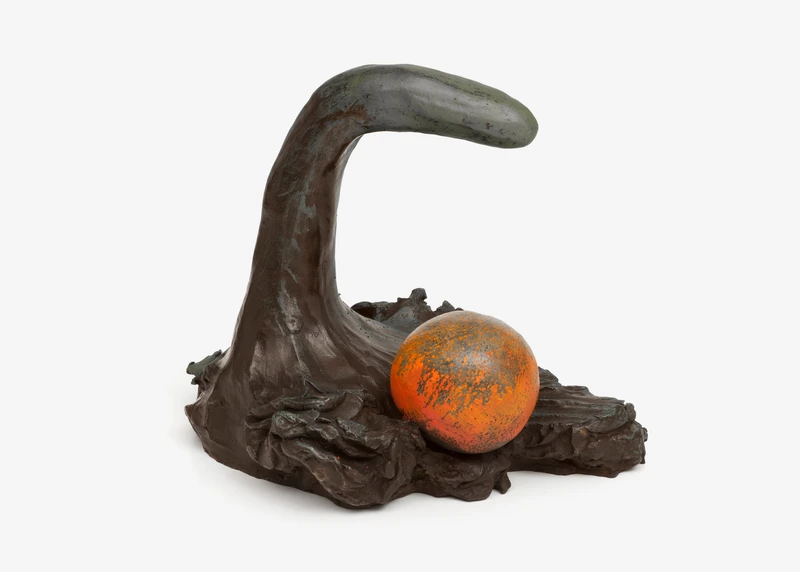Erika Verzutti


b. 1971, Brazil
Erika Verzutti (b.1971, São Paulo, Brazil) has spent the last two decades cultivating a visual language in which painting and sculpture are united. The playful, humorous objects she creates inhabit a spectrum of shapes and scales, and evolve from a core set of materials that include bronze, concrete, clay and papier-mâché. Into these elemental forms, whether a towering floor-based construction or a small rectangular composition, Verzutti integrates watercolour, oil, pigmented wax and acrylic. Components such as eggs, balls and geometric cut-outs, which in many cases are placed into cavities, are also frequently used.
Although the artist draws upon recognisable sources – fruit, gemstones, animals, cemeteries – her sculptures transcend literal associations. As the artist has remarked: ‘I find myself using nature itself as a found object…but [also] inventing my own rules to create a different nature’. Rather than prioritising conceptual or thematic frameworks, Verzutti strives for her art to develop on its own accord. ‘I always try to find fertility in my practice,’ she has said, ‘to have the feeling that the work will naturally grow from a small molecule of a decision’.
Materiality is often the instigator for Verzutti’s creative process: her sculptures are dependent on activating a material and testing its limits. ‘It’s a negotiation between the power of bronze and treating it not as such a precious thing,’ Verzutti says about one of her most relied upon mediums. There is also a reluctance to adhere to traditional hierarchies. Her first papier-mâché work, Grandfather (2014), resulted from ‘knowing that I can do practically anything in a day using only shredded newspaper and glue’. Verzutti continues: ‘My hope is that this autonomy of home-made sculptures ends up contaminating the process of the bronze sculptures’. Such intentions are reiterated by the presence of the artist’s hand throughout her work, as seen through surface indentations and rudimentary outlines.
In her approach to sculpture, Verzutti also positions the object within the realm of the two-dimensional image. This echoes her ongoing interest to engage with images that she sources from the internet, which merge spacial structures and challenge ways of perceiving. In 2013 the artist embarked on a series of shallow rectangular reliefs that were inspired by the shape of an egg carton. Reminiscent of painting palettes, books and make-up sets, Verzutti made the decision to hang these works on the wall, leading to a critical breakthrough for the artist. Most recently, the hyper sensory era of internet culture has proved particularly pertinent, with Verzutti seeking to use her works to push the boundaries of visual stimulation.
Emerging in the early 2000s, the artist’s initial experiments with sculpture centred on gaining an understanding of the inherent qualities of a material – as well as the classical configurations of sculpture itself. ‘I would always try to make a swan or a dinosaur – shapes that were the essential vertical move from the clay up’. Being able to relate form to context – ‘to what I was living through’ – also started to become pivotal to her practice at this time. Verzutti’s experiences at Goldsmiths College, London, where she studied in 1999 had proved revelatory. ‘At university I realised what art really meant in its deepest sense,’ she reflects, ‘I deconstructed many premises I used to believe in.’
Prior to arriving in London, Verzutti had studied graphic design in Sao Paulo. Her interest in art was sparked during this time by radical Brazilian artists emerging in the 1980s, including Leda Catunda and Jac Leirner. Although Verzutti has carved out her own unique trajectory, outside of the traditions of Latin American modernism, the context of Brazil remains important. Verzutti’s wider interest in art history has prevailed through various citations in her work, whether to Picasso and Tarsila do Amaral, or Maria Martins and Henry Moore. ‘Sometimes I don’t know how much of that is a joke,’ she has said. ‘It’s probably more of a serious quote, but I’m hiding behind some funny way to put it out’.